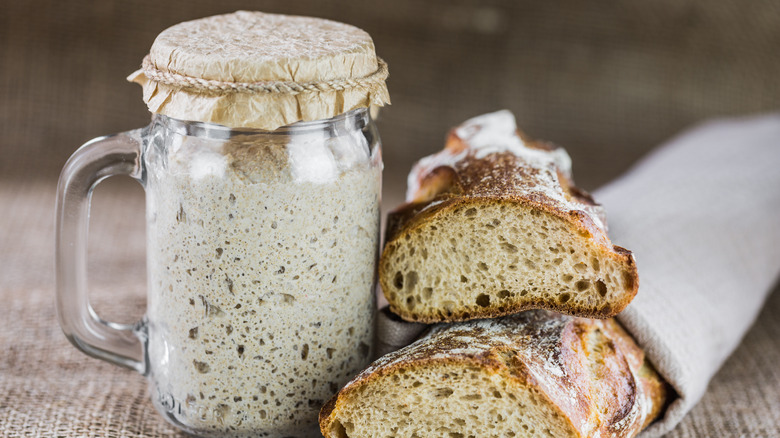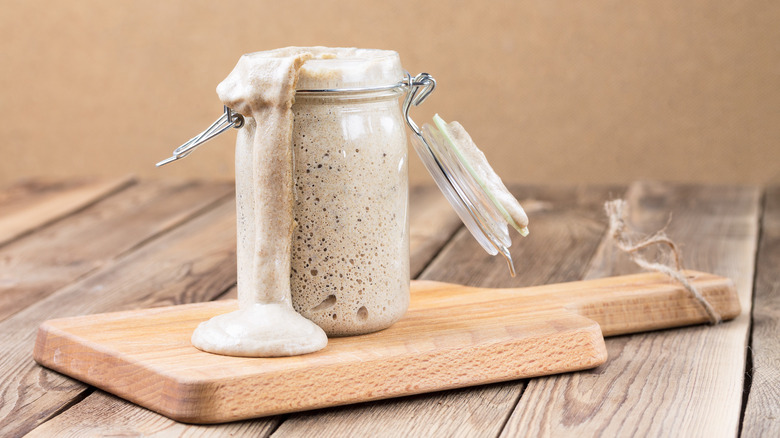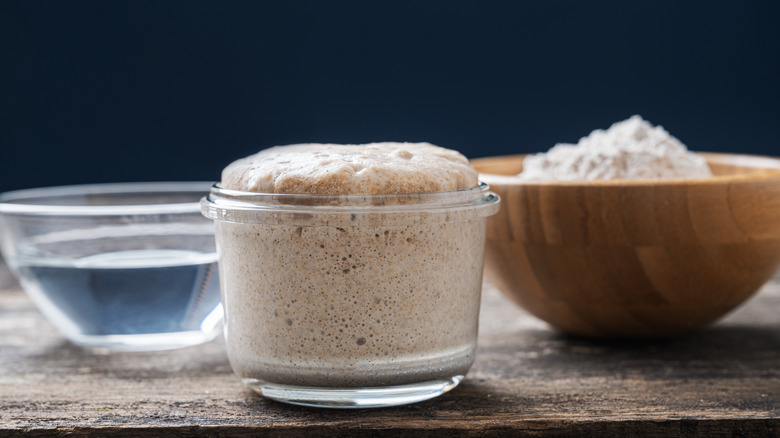How Warm Water Can Help Tell If Your Sourdough Starter Is Ready
They say that in life, timing is everything, and there are few realms where that rings more true than passing trends and sourdough. Trends are cyclical, they come and go, but NPR says that thanks to social media, trends are moving faster than ever. And one that moved faster than many of us could keep up with was baking with sourdough.
Refinery29 reports that in 2020, the hottest trend was raising a sourdough starter of your own and baking the perfect loaf. Folks were stuck at home and decided that it was finally time for them to raise a little one (sourdough starter) and track down a no-knead sourdough recipe. Some bakeries were even giving starters away with bake-at-home kits to help ease some of the rabid demand.
There's plenty to love in sourdough. According to King Arthur Baking, the wild yeasts and bacteria that fuel sourdough's gentle rise add tons of incredible flavors to your bread. Homemade sourdough might even be better for you than other breads.
But just like sourdough's moment in the spotlight, the right time to use it in a recipe can seem like a fleeting moment in time.
Timing is key when it comes to sourdough
King Arthur Baking says that one of sourdough's unique qualities is its need for regular maintenance. A good starter can be used to bake everyday, but no matter what, it requires a daily period of removal and renewal. This keeps the sourdough from growing too large and helps it feed on fresh sugars.
Whether you're just starting a sourdough starter or you've had it going for a few days, you'll need to know the best timing to add it to your recipe. Busby's Bakery says this is usually when sourdough has risen to its peak. That typically means that it has doubled in volume and produced a large quantity of gasses. But as King Arthur Baking points out, this isn't as simple as setting a timer and waiting a few hours until after your feeding. The many qualities of a sourdough starter can change from day to day due to qualities like ambient temperature, which makes working with sourdough a challenging prospect to many.
Luckily, there is a simple way to master its temperamental changes: To make sure you nail the timing, all you'll need is a glass of warm water.
How to do the water test
Food Network says one of the best ways to decide when your sourdough is ready to do its job is to test whether it floats in a container of water. To do this, fill a cup, mug, or bowl part of the way with room temperature or warm water. Then, take a small sample of your bubbling sourdough and place it in the water. If the sourdough sinks to the bottom, you should wait a little longer before adding it to your dough. But a floating piece of sourdough means you're ready to get mixing.
Busby's Bakery says that a good way to approximate the time between feeding your sourdough and when it's worth it to try the water test is to feed your sourdough and check it every hour. Mark its highest point on the outside of the container as it rises each hour until it starts to sink. Then, note the time that it took to reach its highest point and you'll have a pretty good idea of when your sourdough will peak.
Like any good experiment, it's best to maintain the same conditions for your sourdough. So, this might prove to be less accurate if you move your sourdough container or if the ambient temperature rises or drops. But it should still give a good enough approximation though that you can count on the water test to do the rest.


